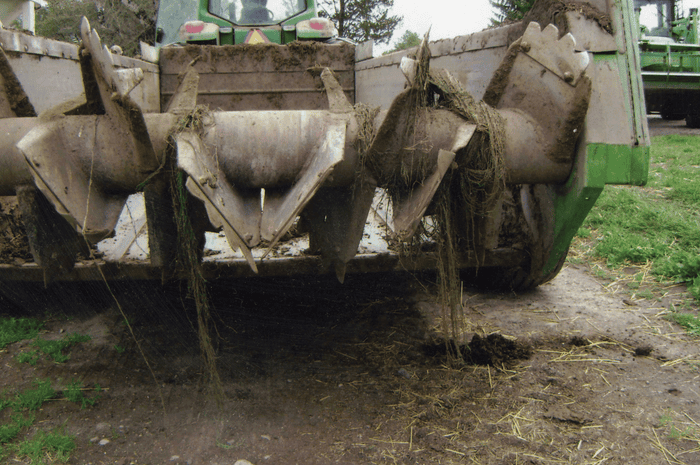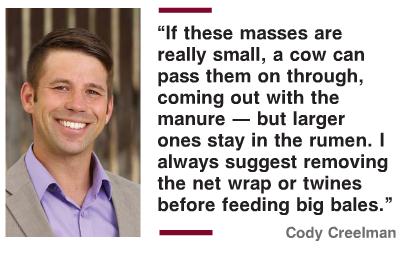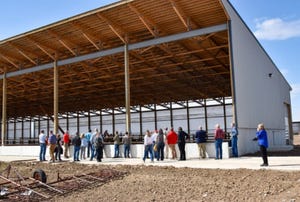Plastic Disease: Another reminder to remove net-wrap
With the advent of net-wrapped round bales, ranchers have another form of hardware disease to worry about — plastic disease.
January 9, 2019

Cattle often ingest foreign objects because they eat hurriedly and wad in a lot of feed at once. Or it may be that they’re just curious. This is why they are vulnerable to hardware disease — nails, staples, wire or other metal pieces that end up in feed and then in the rumen.
They may also consume larger items like twine and plastic garbage. Rather than spit it out, they usually keep chewing on it (whether it’s a piece of twine, net wrap or a plastic bag) and swallow it. Sometimes this material causes problems in the rumen that can be just as damaging and fatal as hardware disease.
That’s leading some producers to discover the risk of leaving net wrap or twine on big bales of hay or straw in feeders or bale grazing, or using a bale processor to chop forage as it’s being fed. Cody Creelman, a veterinarian with Veterinary Agri-Health Services, a five-veterinarian beef cattle practice at Airdrie, Alberta, Canada, says he’s seen instances where pieces of net wrap were clumped into a tight, hard mass — almost like a plastic stone. “In many cases, these might not cause problems just sitting in the rumen, but occasionally create blockage,” he says.
“Many producers never remove net wrap and never have problems, while others say these risks are the reason they always remove net wrap before feeding hay or running it through a processor,” Creelman says.
He experienced one situation where net wrap was the reason for a herd problem. “This producer had a large herd and was bale-busting and processing bales without removing the wrap. He had a high incidence of free-gas bloat, and seven cows died.
“I came out to do post-mortems and was scheduled to do three, but only did two because we were fairly sure [after those two] what happened. In both post-mortems, I pulled concretions, masses of plastic wrap, out of the cow’s esophagus.”
These hard balls were probably floating around in the rumen contents; and when the cow tried to belch, the wad lodged in the esophagus. The subsequent gas buildup in the rumen caused fatal bloat.
“There are three places in the digestive tract where a mass like this might lodge, and one is where the esophagus enters the rumen or reticular groove. In both cows I cut open, this is where these masses were lodged,” he explains.
That producer started removing all net wrap before feeding the bales, and the bloat issue halted. “It surprised me that this problem went away so quickly; I thought it would take longer for something like that to build up,” says Creelman.
“There is variation in how large or small those pieces might be. It might take time for the plastic globs to form in the rumen — maybe weeks or months — but there is no way for the cow to break them down,” he says.
“If these masses are really small, a cow can pass them on through, coming out with the manure — but larger ones stay in the rumen. I always suggest removing the net wrap or twines before feeding big bales,” says Creelman.
It can be difficult, however, if there’s been moisture on the bales and it’s frozen. Some producers drop the bale on the ground from the loader before cutting off twine or net wrap, to help break it loose. If there’s still some frozen hay stuck to part of the wrap, don’t leave that piece in the field where cattle might eat it.
Leaving twine or net wrap on bales in a feeder or out in a pasture can also present a hazard if some gets wrapped around a cow’s feet or leg — cutting off circulation — or around the head and neck.
Still more problems
John Campbell, a veterinarian in the Department of Large Animal Clinical Sciences, Western College of Veterinary Medicine in Saskatoon, Saskatchewan, Canada, did an investigation two years ago when a well-managed cow-calf herd had six cows die within two days. “The local veterinarian asked me to stop by and necropsy two cows that had recently died. These cows were close to calving and in reasonable body condition,” Campbell says.
“The rumens were very large and full of feed, and I found large amounts of net wrap occluding the outflow in both rumens. The producer used a bale processor but did not remove net wrap when processing bales.
“I believe the cows ingested large pieces of net wrap, and it was probably not an issue until they became heavily pregnant. Once the fetus got large enough to restrict abdominal space, and the rumen became huge, the cows died of what appeared to be suffocation,” he says.
“The full rumen and large uterus may have put too much pressure on the lungs. In other instances, net wrap may become entangled with all the food material and create blockage at the exit into the intestine. This creates a slower demise, with the cow losing weight for a period of time.”

Net wrap can remain in the environment indefinitely, meaning it’s not just a threat when left on the bale for cattle to eat. This net wrap did its job a second time when the corrals were cleaned and the manure spread on the field. It wrapped itself around the axle and blades of the manure spreader.
These cows died so quickly that they didn’t lose weight. But in a cow that isn’t heavily pregnant, you might see cows losing weight over a period of time, and having poor appetites. “The net wrap could cause an obstruction to where they are basically impacted, and not much solid feed going through,” he says.
It may be accumulation of small amounts of chopped-up net wrap, or a large piece left on a bale — or not chopped up by the processor. “Perhaps the blades are dull, or net wrap gets wound around them, or sometimes the processor shoots the wrap out in one big piece and doesn’t chop it up. In this instance, it was obvious that the processor was not chopping up the wrap,” says Campbell.
Other junk
Regarding other materials eaten by cattle, Creelman has seen problems when producers use forage along roads. “When baling, they may bale up litter. I had a case in which a cow had been eating hay that was baled along a road, and I pulled out a 30-pound mass from her rumen — a wad of plastic bags and other garbage. The hay cutter chops up this litter, and then it gets baled. Producers need to be aware of this possible hazard,” says Creelman.
Baling twine left in a field can be an issue, even when hanging on a fence. Curious calves chew on just about anything and wad it into their mouths. When a cow gets hold of twine along with a mouthful of feed, she keeps chewing and swallowing.
“I’ve seen a few cases with twine where cows were eating it, then got spooked from where they were feeding and started running off; they have this long piece of twine that keeps coming out of their mouth and esophagus as they are running away,” he says.
 Ingestion of various materials (usually plastic) has become a more common killer, because cattle have access to more litter. A pasture or pen next to a road may have litter from passing cars. A nearby dumpster, construction site or subdivision’s garbage may blow over the fields.
Ingestion of various materials (usually plastic) has become a more common killer, because cattle have access to more litter. A pasture or pen next to a road may have litter from passing cars. A nearby dumpster, construction site or subdivision’s garbage may blow over the fields.
Small pieces may go on through, and you’ll never know the animal ate it. If it’s a large blockage, the animal may stop passing manure and stop eating. The GI tract is “full,” so there’s no room for more feed.
Partial blockage leads to diarrhea, since only the liquid contents make it through. This leads to suspicion of diseases like coccidiosis, salmonella, bovine viral diarrhea, E. coli, Johne’s disease, liver flukes or other parasites — but there is no treatment for “plastic disease.”
“If a person is feeding baled hay and not removing twines or net wrap, this should be considered as a possible cause if cows show digestive issues like bloat or impactions,” says Creelman. “Twines or net wrap can often be removed while the bale is on the loader forks, or being put into a processor.” The extra time it takes can be worth it, in preventing possible problems.
Smith Thomas is a rancher and freelance writer based in Salmon, Idaho.
About the Author(s)
You May Also Like

.png?width=300&auto=webp&quality=80&disable=upscale)
.png?width=300&auto=webp&quality=80&disable=upscale)
